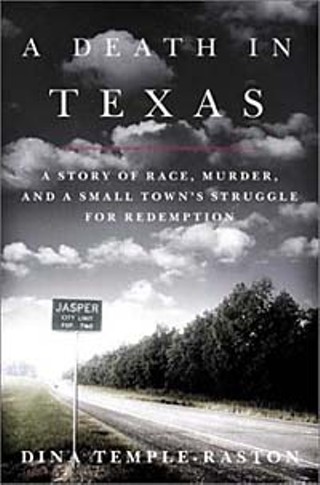True Crime?
Why the 'Statesman' has contacted lawyers for the publisher of an acclaimed book on James Byrd Jr.'s murder
By Shawn Badgley, Fri., June 28, 2002

On Valentine's Day, 1999, the Austin American-Statesman printed a story by staff writer Denise Gamino that explored the 1977 death of Ray Peacock, an 18-year-old black man who had been killed near Jasper, where James Byrd Jr. was brutally murdered on June 6, 1998. "Deep East Texas: The slaying of James Byrd Jr. reawakens memories of another black man's death on a lonely road 21 years earlier" read part of the headline. Three years after Gamino's report, Henry Holt released A Death in Texas: A Story of Race, Murder, and a Small Town's Struggle for Redemption. In it, Dina Temple-Raston, a producer at CNN-FN and a nationally regarded reporter, wrote about both deaths as part of her critically acclaimed, true crime-style study of Jasper in its own tragic and racially volatile aftermath (see austinchronicle.com/issues/dispatch/2002-02-01/books_feature.html for the Chronicle's review). Within days, according to Statesman Managing Editor Fred Zipp and correspondence between him and Holtzbrinck Publishers Holdings LLC -- Holt's German-based umbrella with offices in New York City, and the owner of the likes of St. Martin's Press, Picador, and Farrar, Straus & Giroux, as well -- Gamino noticed striking similarities between her article and Temple-Raston's book, and she told Zipp about it.
"I'd like to direct your attention to photocopies of pages from A Death in Texas that indicate Dina Temple-Raston has borrowed material from a story by staff writer Denise Gamino in the Feb. 14, 1999, Austin American-Statesman," Zipp wrote Holt Contracts Manager Nancy Kenney on Jan. 31 of this year. "Ms. Raston did not credit Ms. Gamino for her work. We consider that a serious breach of scholarly and journalistic ethics."
The "borrowed material" in question was primarily Gamino's exposition on Peacock's death and background, some of which Temple-Raston used verbatim, according to comparisons between Statesman photocopies provided by Zipp and passages in A Death in Texas. In Gamino's fourth paragraph, she refers to Cecil Peacock, Ray's father, as a "stooped woodsman." On p.61 of A Death in Texas, Temple-Raston does the same. In the Statesman, Gamino goes on to write that "[Ray Peacock] returned every weekend to the family's small wooden house in Shankleville, a rural community in Newton County ... On one of Peacock's visits home, someone phoned the Peacock home to say the family's cows were wandering loose on a nearby two-lane highway, Texas 87. Ray Peacock volunteered to round up the cows," while Temple-Raston writes, "Ray Peacock went to college in Beaumont and returned every weekend to his family's small wooden house in Shankleville, a rural community in neighboring Newton County. On one of those visits home, someone phoned the Peacocks to tell them the family's cows were wandering loose on State Highway 87, a two-lane road near their home. Ray Peacock volunteered to go round them up." Gamino's piece continues:
About 11:30 p.m., his car was found on the grassy shoulder. ... A deputy found Peacock's body about 225 feet from the car, face down, with no apparent wounds, according to a sheriff's report. ... That night, two white youths came forward to say their pickup had hit somebody in the foggy darkness.
And Temple-Raston continues:
An hour later, at about 11:30 p.m., his car was found on a grassy shoulder of the road. His body was 225 feet from the car, facedown, with no apparent wounds, according to the sheriff's report. The next night, Rocky Phelps and another white youth came forward to say their pickup had hit someone in the fog.

In addition, Temple-Raston uses a quote -- "It was foul play" -- that Jasper NAACP founder Booker T. Hunter gave Gamino, which would be fine, it being public domain and all, had she not described him almost exactly as the Statesman had, according to the provided documents. "He helped the Peacock family comb through mud and grass the morning after Ray Peacock died to look for clues," reported the newspaper. Temple-Raston: " ... who had helped the Peacocks comb through the mud and grass the morning after the killing to look for clues." Indeed, perhaps everything would be fine had Temple-Raston credited the Statesman at all. Instead, on p.287 of A Death in Texas, which includes "Notes on Sources," the author writes that "The story of Ray Peacock grew out of interviews with family members and friends, discussions with Booker T. Hunter at the National Association for the Advancement of Colored People, and police reports."
"This is to let you know that I've received your letter of January 31st regarding Dina Temple-Raston's book, A DEATH IN TEXAS," Holt Contracts Manager Nancy Kenney e-mailed the Statesman's Fred Zipp on February 1. "Please be assured that we shall look into the matter and will give you our response as soon as possible." That response came on March 21 from Emily Bab Kirsch, one of Holtzbrinck's lawyers. "We thank you for bringing this oversight to our attention," she wrote. "Ms. Temple-Raston had intended to acknowledge certain periodicals that were of help to her in her research as a courtesy and we regret the failure to do so.
Holt intends to correct this oversight. While we see no legal or ethical obligation under the circumstances to provide a credit line to the particular story at issue, any further editions of A Death in Texas will include the sentence: "Stories published at the time and later, during the James Byrd trials, in the Austin-American Statesman and Dallas Morning News also provided valuable details about the death of Ray Peacock and helped me separate fact from rumor."
Days later, Zipp says, he had a telephone conversation with Kirsch and told her that Holt's offer was unacceptable. "She's looking at it from a very narrow-minded, legalistic point of view," he recently told the Chronicle. "For us, it's about academic and journalistic integrity. I told her that the only fair solution was to put the passages that use identical language in quotes, and to attribute it there, as well [Zipp's early notes in the matter also indicate a potential request for permission fees]. They bristled at that."
Zipp says that his phone conversation with Kirsch "degenerated into name-calling," and in early April, he received another letter from the Holtzbrinck assistant general counsel. "I called you on Friday to reiterate that although we feel we are under no obligation to do anything more, we regret that you feel aggrieved," it read. "As a courtesy, I specifically invited you to propose language crediting your newspaper and the journalist who wrote the article in question to appear in any future reprints of the Book. You refused to offer any crediting language or any other solution that you felt would be appropriate under the circumstances and indeed were simply quite belligerent, threatening and unwilling to discuss the matter. ... contact me if you have a proposal. ... Otherwise, the language set forth in my March 21st letter will appear in any future reprints and we will continue to regret your dissatisfaction."
That would prove to be the last correspondence between Zipp and Kirsch, the latter of whom would not comment for this story. But Temple-Raston -- who says that she wasn't informed of the discussions between Zipp and Kirsch -- would. "I thought that this was resolved some time ago," she explains, adding that she has rewritten the passages in question and has drafted an acknowledgment for the paperback edition, due out in January of 2003. "It was an honest mistake; if you look through the book, every other paper I took notes from has been credited, except the Statesman.
"When I found out that this had crept into the text, I was mortified," she continues. "No journalist wants to do anything that isn't their own work, and you want to give credit where credit is due. You want to make sure that you get it right, and I wanted to make this right, right away. I couldn't be more sorry for Denise Gamino, who did the work on this, and she did a great job. She should get credit for it."
Zipp agrees, and says simply that "We're not going to sue them. We're kind of at loggerheads on this issue, and I'm not inclined to spend a lot of money fighting," he says, while calling the offer of a Statesman mention in subsequent editions of the book "empty promises ... We sent [Gamino] over there with a challenging assignment, one that required some really dogged, diligent, resourceful reporting. So to see that work used by Temple-Raston in this fashion has been difficult."








